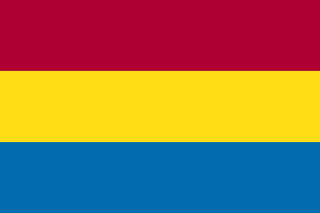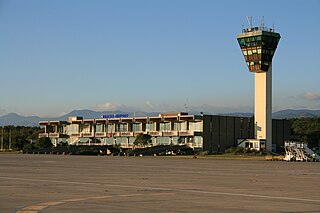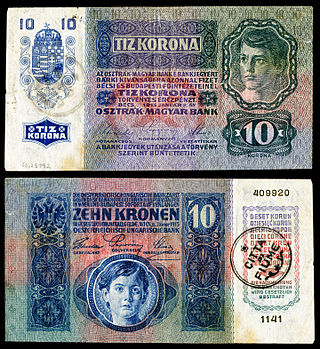
Rijeka, also known as Fiume, is the principal seaport and the third-largest city in Croatia. It is located in Primorje-Gorski Kotar County on Kvarner Bay, an inlet of the Adriatic Sea and in 2021 had a population of 108,622 inhabitants. Historically, because of its strategic position and its excellent deep-water port, the city was fiercely contested, especially between the Holy Roman Empire, Italy and Croatia, changing rulers and demographics many times over centuries. According to the 2011 census data, the majority of its citizens are Croats, along with small numbers of Serbs, Bosniaks and Italians.

Italian irredentism was a political movement during the late nineteenth and early twentieth centuries in Italy with irredentist goals which promoted the unification of geographic areas in which indigenous peoples were considered to be ethnic Italians. At the beginning, the movement promoted the annexation to Italy of territories where Italians formed the absolute majority of the population, but retained by the Austrian Empire after the Third Italian War of Independence in 1866. During World War One the main "irredent lands" were considered to be the provinces of Trento and Trieste and, in a narrow sense, irredentists referred to the Italian patriots living in these two areas.

Hrvatski nogometni klub Rijeka, commonly referred to as NK Rijeka or simply Rijeka, is a Croatian professional football club from the city of Rijeka.

The Julian March, also called Julian Venetia, is an area of southeastern Europe which is currently divided among Croatia, Italy, and Slovenia. The term was coined in 1863 by the Italian linguist Graziadio Isaia Ascoli, a native of the area, to demonstrate that the Austrian Littoral, Veneto, Friuli, and Trentino shared a common Italian linguistic identity. Ascoli emphasized the Augustan partition of Roman Italy at the beginning of the Empire, when Venetia et Histria was Regio X.
Ivan von Zajc, was a Croatian composer, conductor, director, and teacher who dominated Croatia's musical culture for over forty years. Through his artistic and institutional reform efforts, he is credited with its revitalization and refinement, paving the way for new and significant Croatian musical achievements in the 20th century. He is often called the Croatian Verdi.

Kantrida Stadium is a football stadium in the Croatian city of Rijeka. It is named after the Kantrida neighbourhood in which it is located, in the western part of the city. It has served as the home of the HNK Rijeka football club for most years since at least 1918. The stadium has a distinctive appearance as it is situated between steep cliffs, a remnant of an old quarry, just north of the stadium and the shore of the Adriatic on its south side.


The Istrian–Dalmatian exodus was the post-World War II exodus and departure of local ethnic Italians as well as ethnic Slovenes, Croats, and Istro-Romanians from Yugoslavia. The emigrants, who had lived in the now Yugoslav territories of the Julian March, Kvarner and Dalmatia, largely went to Italy, but some joined the Italian diaspora in the Americas, Australia and South Africa. These regions were ethnically mixed, with long-established historic Croatian, Italian, and Slovene communities. After World War I, the Kingdom of Italy annexed Istria, Kvarner, the Julian March and parts of Dalmatia including the city of Zadar. At the end of World War II, under the Allies' Treaty of Peace with Italy, the former Italian territories in Istria, Kvarner, the Julian March and Dalmatia were assigned to the nation of Yugoslavia, except for the Province of Trieste. The former territories absorbed into Yugoslavia are part of present-day Croatia and Slovenia.

Rijeka Airport is the international airport serving Rijeka, Croatia. It is located near the town of Omišalj on the island of Krk, 17 km from the Rijeka railway station. Most of the traffic to and from the airport occurs during the summer months, when it is used by several European low-cost airlines flying tourists to the northern parts of the Croatian coast.

Alvaro Načinović is a former Croatian handball player who competed for Yugoslavia and Croatia respectively.
Rijeka, formerly known as Fiume, is a city located in the northern tip of the Kvarner Gulf in the northern Adriatic. It is currently the third-largest city in Croatia. It was part of the Roman province of Dalmatia, and later of the Kingdom of Croatia. It grew during the 12th to 14th centuries as a seaport within the Holy Roman Empire, trading with Italian cities. Under the rule of the House of Habsburg from 1466, it was made a free city; and, although part of the Duchy of Carniola, it developed local self-government.

The Fiume Krone was introduced in the Free State of Fiume on 18 April 1919 by the National Council of Fiume who effectively exercised power in the City through stamping of the previous Austro-Hungarian Krone notes. After the Dannunzian occupation in September 1919, a new series of notes were stamped on behalf of the Istituto di credito del Consiglio Nazionale with a decree dated 6 October 1919. The Fiume Krone was the official currency of the City of Fiume up to 26 September 1920 when, by the decree of the general Amantea commander of the Italian troops in Fiume, the Italian lira was introduced as the new official currency. The currency continued to circulate until the annexation of the city to Italy in February 1924. The royal decree n 235 of 24 February 1924 set the final conversion date on April 30, 1924, at 0.40 Italian lira for one Corona Fiumana.

Istrian Italians are an ethnic group from the Adriatic region of Istria in modern northwestern Croatia and southwestern Slovenia. Istrian Italians descend from the original Latinized population of Roman Histria, from the Venetian-speaking settlers who colonized the region during the time of the Republic of Venice, and from the local Croatian people who culturally assimilated.
The Fiuman dialect is the dialect of the Venetian language spoken in the Croatian city of Rijeka (Fiume). It is strongly influenced by Croatian Chakavian, Hungarian, German substrates, mainly due to the closeness between two different cultures and Austro-Hungarian rule.

Italians of Croatia are an autochthonous historical national minority recognized by the Constitution of Croatia. As such, they elect a special representative to the Croatian Parliament. There is Italian Union of Croatia and Slovenia, in Croat Talijanska Unija, in Slovene Italijanska Unija, which is Croat-Slovene organization with main site in Fiume-Rijeka and secondary site in Capodistria-Koper of Slovenia.

Vladimir Lukarić is a former Croatian football player and manager. He has had six appearances for the Yugoslavia national team, scoring his only goal against Ethiopia in 1962.
Mario Blasich was an Italian politician and physician, and an important member of the Autonomist Party of Fiume, during the short lived autonomy of the Free State of Fiume.

The Province of Fiume was a province of the Kingdom of Italy from 1924 to 1943, then under control of the Italian Social Republic and German Wehrmacht from 1943 to 1945. Its capital was the city of Fiume. It took the other name after the Gulf of Carnaro.
The Bloody Christmas of 1920 was a series of clashes in Fiume, which led to the conclusion of the Fiume campaign that was carried out by the Italian poet and adventurer Gabriele D'Annunzio in 1920.
The Fiume Autonomists purge, or the purge of the Autonomist elements of the city of Fiume, was a series of well orchestrated killings of the most prominent politicians and intellectuals of the Autonomist Party of Fiume or Rijeka.













